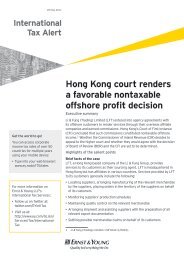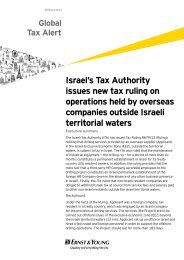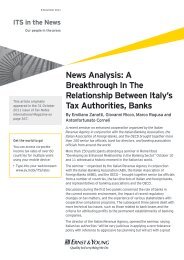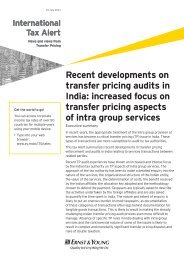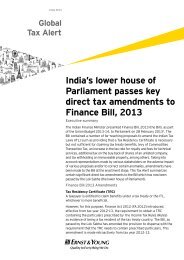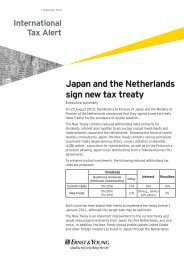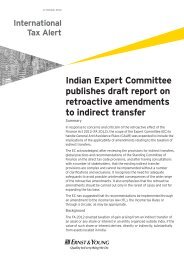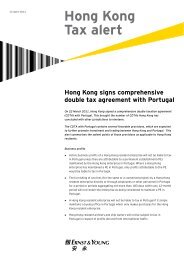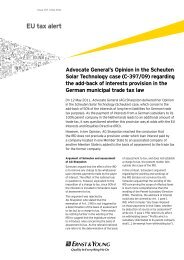Download - Ernst & Young T Magazine
Download - Ernst & Young T Magazine
Download - Ernst & Young T Magazine
Create successful ePaper yourself
Turn your PDF publications into a flip-book with our unique Google optimized e-Paper software.
Living costs<br />
The relative costs of the world’s business cities are evolving<br />
in line with shifts in the global economy.<br />
• By Nigel Holloway<br />
Globalization is both a product of and a<br />
contributing factor of economic integration.<br />
As national markets become increasingly<br />
connected, the demand among international<br />
employers for globally-minded executives has<br />
grown. For the jet-setting business traveler, many<br />
markets can seem fairly homogeneous, as they<br />
travel from hotel to hotel, their feet barely<br />
touching the ground.<br />
Yet, despite the trend toward globalization,<br />
the cost of living varies almost as widely from<br />
city to city today as it did 20 years ago. This<br />
is a problem not only for expatriate business<br />
executives trying to maintain their living<br />
standard. It is also a headache for their<br />
employers that seek to keep their top talent<br />
happy, while deploying them around the world<br />
wherever the need is greatest.<br />
With the expatriate in mind, the Economist<br />
Intelligence Unit (EIU) has collected price data<br />
from cities around the world for more than<br />
two decades, comparing costs such as home<br />
rental, private school tuition and the costs of<br />
domestic help. It then ranks the cities on an<br />
index, using New York as a constant baseline at<br />
100. Today, the most expensive city in the world,<br />
Zurich, is at 170, meaning that costs there<br />
are 70% higher than New York’s. Twenty years<br />
ago, the most expensive, Tokyo, was at 171.<br />
The cheapest city today is Karachi at 46. In<br />
1992, the cheapest was Mumbai at 32, which<br />
this year ranked just above Karachi.<br />
Generally, cities in the developed markets of<br />
Europe and Japan are among the most<br />
expensive. Their individual rankings bounce up<br />
and down according to exchange rate<br />
movements, but they remain in the same richer<br />
group. By the same token, cities in the<br />
fast-growth regions of Asia and the Middle East<br />
are among the cheapest. But there are some<br />
notable exceptions. Singapore, for example, is<br />
now in the top 10 and 42% pricier than New<br />
York, thanks to soaring rents and a strong<br />
exchange rate. It is now far more expensive than<br />
rival Hong Kong (115 on the index) and<br />
neighboring Kuala Lumpur (83). Nor are all cities<br />
in other rapidly growing countries cheap.<br />
Luanda, the oil-rich capital of Angola, was one<br />
of the most expensive cities in the world for<br />
expatriates in 2011. Two other African cities<br />
were also prominent on a the list, Ndjamena,<br />
Chad and Libreville, Gabon. Energy and mining<br />
companies have been lured there by the promise<br />
of natural resources. But the lack of<br />
infrastructure means that these firms must build<br />
their own housing and amenities, resulting in<br />
high costs for expatriates’ employers.<br />
Cheapness, in and of itself, does not<br />
necessarily make a city attractive. But as the<br />
global economy tilts towards fast-growth markets,<br />
an increasing number of professionals are seeing<br />
cities in those markets both as a source of jobs<br />
and as places that offer a boost to their careers.<br />
Inevitably, as demand for fine housing grows,<br />
prices go up. Shanghai, on a par with Moscow, is<br />
now slightly more pricey than New York. São<br />
Paulo in Brazil is 12% more expensive than New<br />
York, and pricier than Rome and Berlin.<br />
And the variations within countries are often<br />
as great as from one nation to another. Thanks<br />
to the weak US dollar, American cities are in the<br />
middle of the global rankings. But the gap<br />
between the top (Los Angeles at 102) and the<br />
cheapest (Cleveland at 73) is greater than<br />
between Shanghai (102) and Tianjin (79). In the<br />
US, high unemployment and falling rents have<br />
made the traditional manufacturing heartland<br />
a cheap region in which to do business.<br />
Overall, though, the cities with the lowest<br />
expatriate costs tend to be in non-western<br />
countries. Mumbai, New Delhi, even Panama City<br />
(42% less expensive than New York) would seem<br />
to present enticing bargains to the expatriate.<br />
The question arises, though, as to how much<br />
longer such disparities will last. The foreign<br />
executive living in the lap of luxury on a foreign<br />
assignment, with domestic help covering the<br />
daily chores, may become a thing of the past,<br />
not least as cheap labour finds better-paying jobs<br />
in manufacturing or IT. Indeed, a popular<br />
complaint for wealthy households in São Paolo<br />
today is the soaring cost of domestic labor, as<br />
the pool of available nannies, cooks and cleaners<br />
dries up. Such changes will continue as the<br />
balance of power in the global economy shifts<br />
towards key growth markets.<br />
<strong>Ernst</strong> & <strong>Young</strong> Issue 07 T <strong>Magazine</strong> 23



